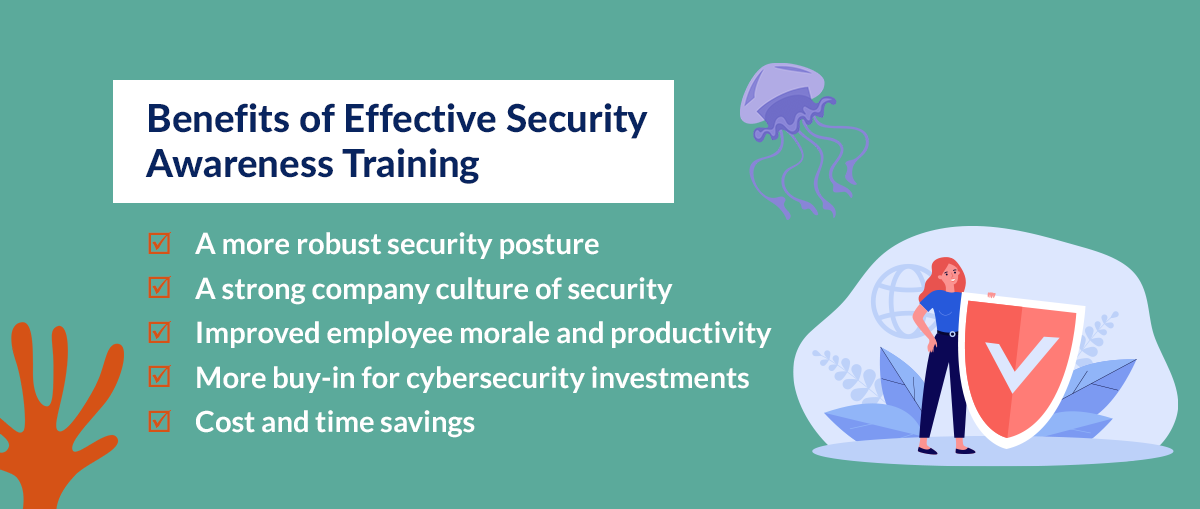


What is Security Awareness Training?



Security awareness training is training for individuals to identify and respond appropriately to information security threats. Of course, if that were it, security awareness training wouldn’t be a rapidly growing multi-billion-dollar industry.
This article will cover the human threat landscape, suggestions about what to include in a modern security awareness training program, and tips you can use to improve security awareness training efficacy.
Jump To:
- Security Awareness Training Defined
- Benefits of Security Awareness Training
- Recognizing a Need for Training
- How to Strengthen Your Program
- Best Practices
Security Awareness Training Defined
At its core, security awareness training teaches employees how to respond to cybersecurity threats. Because human involvement is a critical factor in 74% of data breaches, training people to handle new and evolving cyber threats properly is necessary for protecting company and personal data.
That said, few company leaders really understand what training is and what it can do. Let's debunk some popular misconceptions around the topic:
- Training is a one-off event: While most organizations approach training as a single annual obligation, it needs to be more frequent to achieve the results you want. Continuous security awareness training helps you build a culture of cybersecurity and effect lasting behavioral change.
- Only technical staff need training: Contrary to popular belief, cybercrime can affect anyone in your organization. Bringing everyone on board through routine training is essential.
- It's an unnecessary cost: Many company leaders view security training as an ineffective waste, but it can bring your organization significant financial and reputational benefits when implemented correctly.
- Only large organizations need training: While media coverage makes it seem like only big players fall victim to cybercrime, smaller organizations are usually the most vulnerable because they lack the security resources big companies have. That's why small-to-medium-sized businesses (SMBs) are the ones who need training the most.
- New security technology is enough: Advanced tech is great, but training your employees to use it well is critical for making your investment worth the cost.
- Employees don't remember training: When you don't make an effort to make training engaging and relevant to your employees, they're more likely to tune out and forget what they learned. But a good training program that prioritizes employee engagement will help you ensure your lessons stick.
Some security awareness training programs are more effective than others. The key is to make sure yours is frequent, relevant and transparent — these are the ingredients to lasting learning.
Benefits of Effective Security Awareness Training

Essentially, awareness is critical for effectively combating new and improved cyber threats as they arise. But a strong security awareness training program can bring your organization many other benefits, such as:
- A more robust security posture
- A strong company culture of security
- Improved employee morale and productivity
- More buy-in for cybersecurity investments
- Cost and time savings
The Human Threat Landscape: A Call for Enhanced Awareness
Cybercrime is increasing at alarming rates every year. Long gone are the days of the stereotypical late-90s to early-2000s cybercriminals: nerds sitting in their parent’s basements banging away at keyboards. Cybercrime is a multi-trillion-dollar industry, projected to grow to $10.5 trillion in a couple of years. Cybercriminals are sophisticated, highly-motivated threat actors, and the most successful are sponsored by nation-states or work in large billion-dollar criminal firms.
Security awareness programs are implemented by businesses to train their employees to combat those firms by encouraging safe and secure use of computers, information, email, and the internet. Businesses are highly incentivized to do so. Numerous types of attacks start with an organization’s most valuable—and most vulnerable—resource: its people. Here are some of the most common cyber threats to individuals and businesses.
Recognizing and Responding to Phishing Attacks
“Phishing” is an attack involving a cybercriminal sending emails to individuals en masse with the hopes of catching one of them off guard. “Spearphishing” is a variant of a typical phishing attack where specific individuals are targeted with phishing emails because of their position, wealth, fame, etc.
Phishing attacks commonly manifest in a few different ways:
- An urgent request for information (typically personally identifiable information or banking information) or money
- An email with an attachment that, when opened, deploys malware on the target computer – most ransomware attacks, cyberattacks that cripple businesses by encrypting information and making it inaccessible without payment, is started by an employee succumbing to a phishing attack containing a malicious file.
Phishing and ransomware attacks cost individual businesses millions of dollars annually — approximately $1500 per employee in 2021 — with a total cost of many billions of dollars worldwide annually. Those figures don’t account for individual compromise and loss, which is difficult to quantify due to a lack of comprehensive reporting.
Phishing security testing — an interactive type of training that simulates phishing attacks — teaches employees what to do and what not to do when they think an email is fraudulent. Simulation is an essential tool in any security awareness training program.
Building a Defensive Workforce Against Cyber Threats
In plain language, a modern security awareness training program should provide an understanding of:
- Why cybersecurity protections are in place
- How to spot threats
- How to leverage cybersecurity protections
By covering those topics, individuals are not only informed that they ought not to do certain things. They’re told the criticality of their role in information security, the importance of their role, and how to defend against cyberattacks effectively.
Building individual participation is key to defending against cyberattacks. Businesses are operated by people, all of whom are susceptible to compromise. Cybercriminals typically pursue the most effective modalities for compromise; they only make money if they conduct a successful cyberattack. The rise in human-focused modalities of compromise demonstrates the overall efficacy of human compromise. People feel more personally invested in cybersecurity by building individual participation and emphasizing the criticality of individual participation in cybersecurity.
The key to building that individual participation is informing people why cybersecurity protections are in place. There are typically two primary areas of focus on the “why” of cybersecurity:
- What cybersecurity threats exist?
- What are the consequences of a successful attack?
An overview of the different cyberattack modalities is critical to building a foundation for the training—what an organization is defending against—and provides a solid background for spotting and avoiding those threats.
Strengthening Security Awareness Programs
There may be threats not covered in training. That’s ok. No one has an exhaustive list of cyberattack modalities. Frankly, the threat landscape develops and shifts quickly enough that it may be impossible to have one single canonical list of threats.
Additionally, providing a comprehensive list of threats will be an information overload for individuals taking the training. No one really needs to know about esoteric cyberattack modalities that might be a successful one in a million times at organizations that are completely unprepared for a cyberattack (which would be a feat in a world where basic cybersecurity safeguards are built into operating systems and provided by internet service providers by default). Security awareness training that focuses on the top five threats in a relevant industry will go a long way in upgrading an organization’s security posture.
Simulation's Role in Employee Security Awareness Enhancement
The flip side of that, then, is empowering individuals to identify and avoid threats. The best way to identify threats is to know how they operate. Provide examples of phishing emails, let people know that malicious websites exist, and inform the reader what general safeguards exist at the organization. Some examples of safeguard exposure may include:
- Are browser sessions sandboxed?
- Is there a way to encrypt email?
- Are there general obligations for the safe handling of information?
Training that provides essential security information without fundamentally compromising organizational safeguards is critical to people recognizing an attack and hopefully stopping it before it impacts themselves or the organization.
Once safeguards are identified, let people know how to use them:
- Is there a way to report phishing emails?
- How does someone inform information security or IT staff of odd computer performance issues?
- Can people reset their password on their own, or do they need to call IT support?
It’s also a good idea to define and encourage folks to use administrative safety tools. One of the most effective, that I’m sure everyone’s heard by now is: “if you see something, say something.” Other safety tools may provide steps for incident escalation: identify, triage, report, and respond. The sooner that the staff closest to the start of a cyberattack know what to do and how to do it, the more effective and rapid the response.
The Imperative of Continuous Security Awareness Training
The threat landscape is constantly shifting and evolving, and failure to keep up with new cyber threats can put both employee and organization security at risk.
Take phishing, for example. While you might believe your employees can spot a phishing email from a mile away, cybercriminals have begun using generative AI models like ChatGPT to craft more sophisticated emails. And with the rise of deep fakes and similar scams, it's becoming harder for the average person to tell the real from the fraudulent.
Continuous security awareness campaigns are essential for preparing your employees to respond to new threats before they encounter them. And that minimizes their risk of becoming insider threats themselves.
Analyzing the Return on Investment in Security Awareness Training
When you weigh out the costs of cybercrime and cybersecurity training, it's clear that regular security awareness training is a cost-effective solution.
The consequences of a successful attack go beyond financial damage, as reputational damage can also seriously impact an organization. According to IBM, the average cost of a data breach is $4.45 million. Organizations may have hundreds, thousands, or millions of records containing their customers’ most sensitive information. Data breaches can destroy livelihoods and reputations, and there are too many examples of precisely that happening through identity theft.
What's important to remember here is that your employees are your first and last line of defense, whether they're in IT or HR. Setting an expectation that all employees are personally responsible for the safety of that data establishes severe and definite responsibility. Plus, you'll be able to reduce cybersecurity costs in the long run by stopping smaller threats as they appear.
Implementing Best Practices in Security Awareness Programs
You could have the best-designed security awareness training program in the business world, but are your employees practicing the lessons they're learning?
Clear communication and frequent training are two key components of an effective security awareness program.
Fostering Clear Communication for Successful Security Awareness
Getting the news out is the best way to build awareness, which is why repetition is your friend. It’s great to have annual security awareness training. It’s even better to make that training more regular. Keeping messaging fresh but repeating core principles will also help solidify good cybersecurity awareness.
Here are some suggestions of ways you can reinforce key training messages without being overbearing:
- Sending out a newsletter and email
- Publishing an internal blog
- Putting up posters
- Running brown-bag lunches
- Talking to organizational leaders about cybersecurity messaging to staff
Anything you can do to get the word out will go a long way to inform about cybersecurity awareness and help build a culture of safe behavior.
Although the shifting cybersecurity threat landscape and media sensationalism surrounding high-profile attacks means every attack is different, the impact remains the same. Businesses lose money, and people's lives become more complicated as a result.
Given the volume of attacks, it’s convenient to use those to reinforce the message that cybersecurity is everyone’s responsibility and anyone can be impacted. It’s very difficult to become desensitized to something personally relevant and over which someone has personal responsibility.
The “Train, Train, Train” Philosophy
The key to a truly successful cybersecurity awareness training program is constant drilling on incident management and business continuity processes. No matter how many training materials are distributed, how much cyber safety is communicated, or how significant the depth of defense of cybersecurity infrastructure is, succumbing to a cyberattack is a matter of “when” and not “if.”
Against that backdrop, organizations must ensure that the first time they’re testing their incident response and disaster recovery processes isn’t during a frantically high-pressure situation like an active cyberattack. The cost of downtime and reputational impact is too significant not to prepare for the eventuality of an attack.
Organizations are generally recommended to conduct at least one cybersecurity incident tabletop annually. The focus of that tabletop should be incident response, communication, and disaster recovery. Key questions to ask during that exercise may include:
- What do our processes look like?
- Are key stakeholders aware of the processes required in security awareness training?
- What’s the path of escalation within the organization?
- Who makes the decision to pay a ransom?
- Who makes the decision to disable infrastructure to isolate the spread of an attack and purge the malicious code?
- What federal, state, and internal reporting requirements are there?
- How are you communicating internally?
- How do you communicate with the public at large?
- What does business continuity and attack recovery look like?
- What services can be provided during an attack? What cannot?
Ideally, an organization is testing subsets of those processes with parts of the organization more frequently than annually. Even more ideally – those tabletop exercises are paired with a risk management program that helps guide activities based on areas of significant risk.
Conclusion and Key Takeaways
If there’s one thing you take away from this, it’s that solid security awareness training stops cyberattacks. If there are two things you take away from this, it’s that cyberattacks are expensive and potentially catastrophic, and there isn’t such a thing as “too much preparation.” Cybercriminals are highly incentivized to steal from individuals and businesses — the stakes are trillions of dollars worldwide. The best defense is knowledge: if employees know what to look for, they can stop a cyberattack before it starts.
Explore the Benefits of Phin's Security Training Solutions
At Phin Security, we offer value you won't find anywhere else. We understand the common pitfalls of traditional security awareness training, which is why we createda centralized and hands-off platform that runs engaging training campaigns while allowing you to focus on business continuity.
Real-time analytics and detailed training reports provide the insights you need to quickly adjust training campaigns for continuous improvement. Our intuitive, automated onboarding process can help you and your clients get started in just 10 minutes.
Stat a Free Trial today to see Phin Security's innovative platform in action.







Leave a comment: